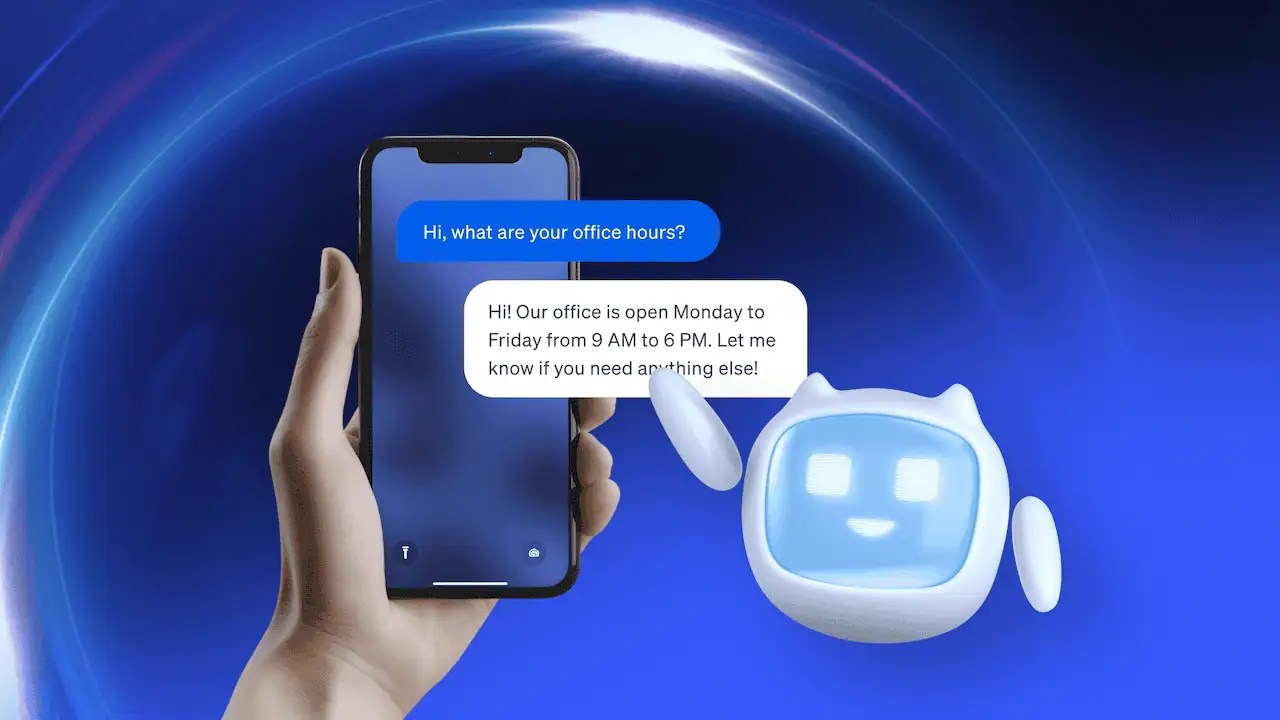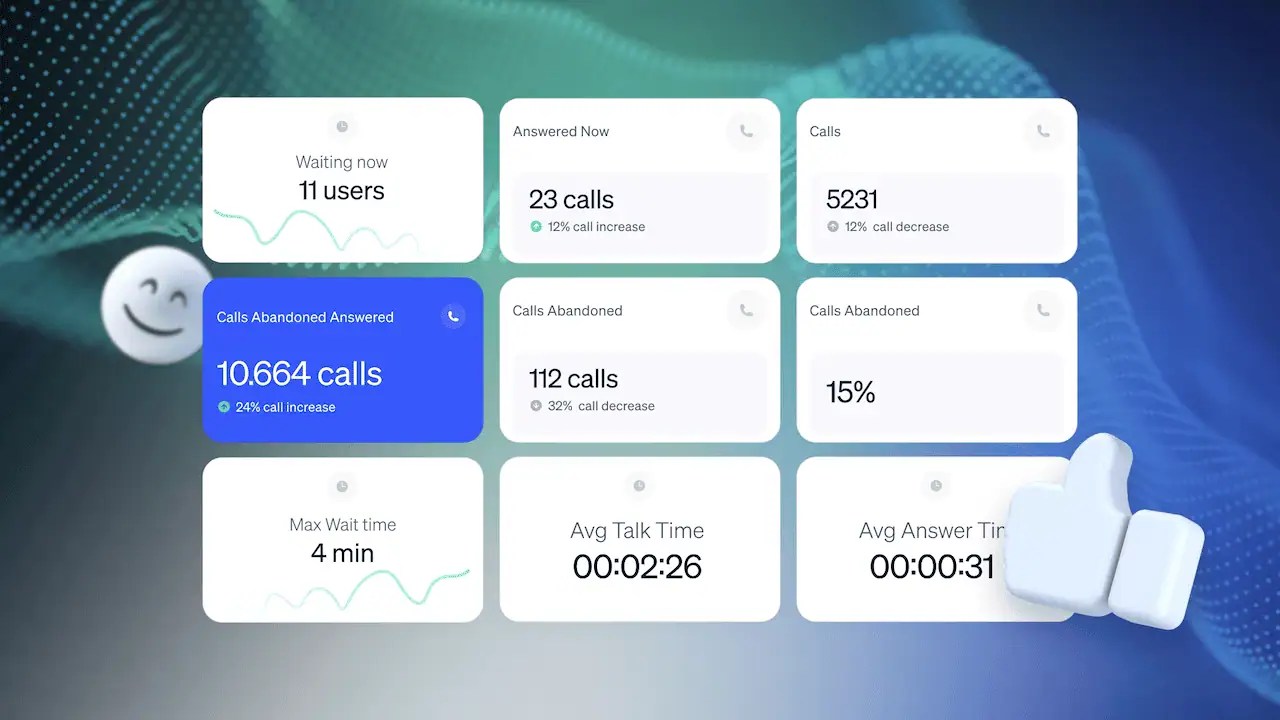Forget long hold times. Delighting customers means resolving their issues quickly on the first call. First call resolution (FCR) tackles this head-on, reducing customer frustration and delivering the fast service they expect.
This article will show you how to boost your FCR, free up your team’s time, and create happier customers.
What Is First Call Resolution (FCR)?
First Call Resolution (FCR) is a metric used in call centers to measure how many customer interactions are resolved on the very first contact, eliminating the need for any follow-up calls or contacts. It’s essentially a way to gauge a call center’s efficiency in resolving customer issues.
FCR considers situations where a customer’s problem is resolved:
- Without requiring an escalation to a supervisor or specialist
- Without transferring the call to another department
- Without scheduling a callback for a later resolution
- Without needing to create a separate help desk ticket for further investigation
A high FCR rate indicates a well-functioning customer service team that can efficiently handle customer inquiries. Companies typically set FCR targets to track progress and identify areas for improvement.

Why Is FCR Important? (+Benefits)
A strong first-call resolution rate is a hallmark of excellent customer support. By tracking and improving FCR, contact centers can streamline operations and get several key advantages:
- Enhanced customer satisfaction: Customers appreciate having their issues resolved in a single interaction. A high FCR demonstrates that you prioritize customer needs and can solve problems efficiently. This shows respect for their valuable time.
- Improved customer journey: FCR directly correlates with quick resolution, minimal wait times, and single points of contact. Time after time, the numbers speak for themselves. Customers love FCR, and the results benefit a company’s bottom line.
- Reduced average handle time (AHT): When agents resolve issues quickly, it signifies a more efficient operation. They can address a higher volume of support requests without sacrificing quality service.
- Lower operational costs: FCR directly reduces costs associated with callbacks, transfers, and escalations. It minimizes the need for additional customer contacts, leading to lower operational expenses.
- Boosted agent morale: Support agents feel a sense of accomplishment when they independently resolve customer issues. This success contributes to higher job satisfaction and motivation.
- Valuable metrics and insights: FCR is a key performance indicator (KPI). It provides valuable insights into the effectiveness of your knowledge base, agent tools, and training programs.
- Improved customer retention: Frictionless service experiences foster customer loyalty. High FCR minimizes customer effort and strengthens customer satisfaction, leading to a more loyal customer base.
- Continuous improvement: FCR reporting helps identify areas for improvement. Analyzing these insights helps you optimize processes, refine agent training, and enhance the customer experience through ongoing improvement cycles.

“If you handle 1,000 interactions per week, and your average first contact resolution rate is 70%), that means that 30% of your tickets require multiple responses. Increasing your typical first contact resolution rate by just ten points to an 80% success rate means you’ll send at least 300 fewer emails per week or 15,600 per year.”
Len Markidan
A strong FCR strategy benefits both your customers and your business. It fosters positive customer experiences, increases efficiency, and empowers your call center agents.
How To Calculate First Call Resolution (FCR Formula)
The formula for calculating your FCR rate is:
Number of issues resolved on first contact / Total number of customer contacts x 100
This gives you a clear percentage of inquiries where the customer didn’t need to make further contact to have their issue addressed entirely.
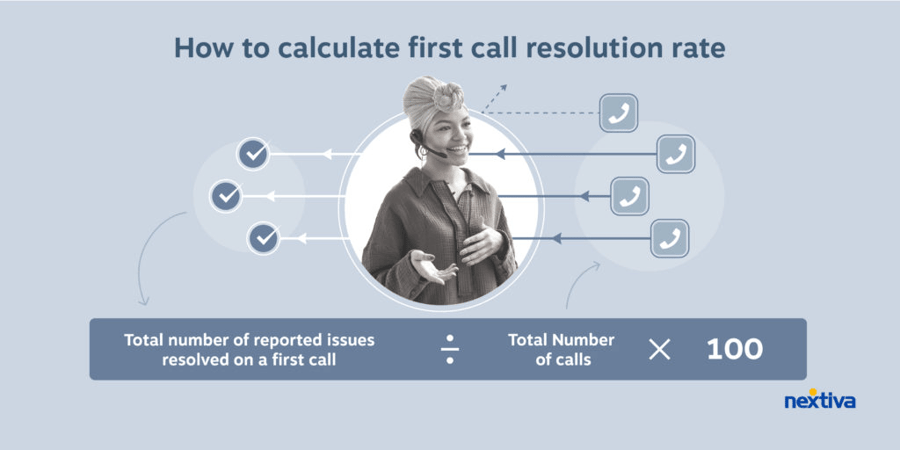
Alternative calculation (with a caveat)
An alternative method is to divide the number of issues resolved on the first calls by the total number of first calls received. However, this approach doesn’t account for contacts made through other channels (chat, email) and might misrepresent the FCR rate.
There are important considerations when interpreting FCR data. For instance, some customer interactions may involve complex issues requiring escalation, which wouldn’t necessarily reflect poorly on the agent’s ability.
FCR should be viewed as one piece of the puzzle alongside other call center metrics like customer satisfaction and average handle time.
What’s a good FCR rate?
A good FCR target rate depends on your industry, but a range of 70-75% is the industry standard for strong call centers. This means approximately 3 in 4 issues should be handled in one contact.
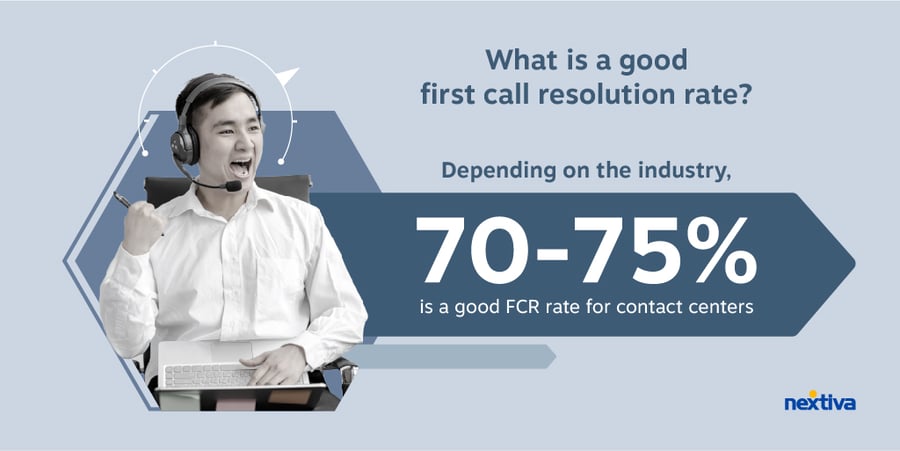
That said, there’s no single “good” first contact resolution rate that applies universally, as the target can vary by company size, support channels, and the recency of the product/service.
Here are some general FCR rate benchmarks:
- World-class customer service: 80%+
- Strong performance: 70-79%
- Average: 60-69%
- Needs improvement: Under 60%
The key is to compare your FCR rate to past performance, not industry averages. Focus on continuous improvement vs. chasing static targets.
Tips for Improving FCR
First contact resolution is a golden metric in customer service. Here are a few call resolution best practices and strategies to empower your support team, streamline processes, and achieve higher FCR rates.
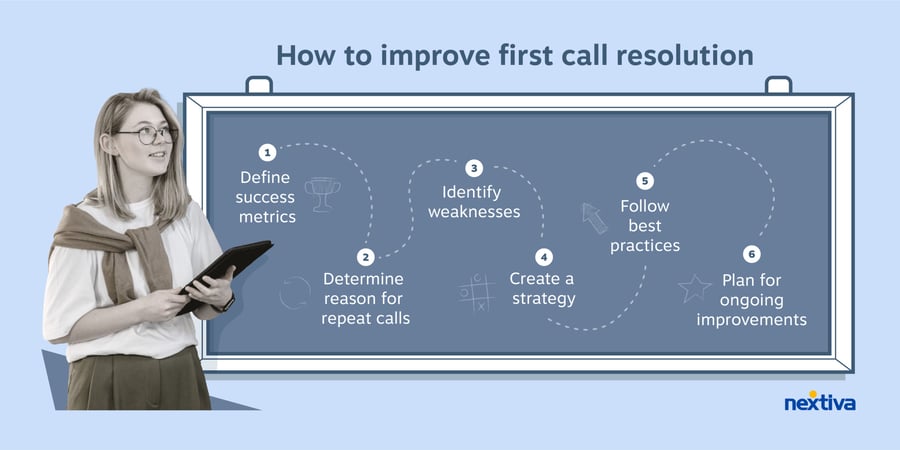
1. Set customer-centric FCR benchmarks
Research what FCR rate is typical for your industry and consider how complicated your customer calls usually are.
Then use surveys and call recordings to see what a great resolution looks like from your customers’ perspective. This will help you set goals that are both ambitious and achievable, and that keep your customers happy.
Be prepared to adjust these goals if you get slammed with more calls than usual — having extra staff or a backup call center ready can help you maintain a high FCR even during peak times. Don’t forget to track your progress regularly and update your goals as things change.
2. Empower your agents
Give your agents all the knowledge they need with comprehensive guides, clear rules for making decisions, and access to experts for tricky situations.
Communication is key too, so invest in training and tutorials that help agents connect with customers, explain things clearly, and keep good records of what’s going on.
And because things can always get better, provide ongoing training to sharpen their problem-solving skills and keep their product knowledge up-to-date.
Role-playing exercises can be a great way to practice handling unexpected situations that come up. Finally, make sure your training is on point by encouraging agents to share their feedback and suggest improvements.

3. Streamline your processes for efficiency
Standardize how you handle common issues so everyone’s on the same page. Design workflows that free up agents to focus on solving problems, not wrestling with complex systems.
Use call data and info about your customers to find areas where you can improve training, processes, or even company policies. Don’t just focus on the contact center — look for root causes of repeat calls outside the center too, like maybe outdated documents or departments not talking to each other.

Be upfront with customers about what’s happening and how long things might take. Setting expectations from the start helps avoid frustration and clarifies what can be accomplished in a single call.
4. Leverage the right tools & technology
Use smart call center software to get customers to the right agent for the job, depending on their issue and the agent’s skills.
Automation and self-service options like chatbots or online knowledge bases can handle simple questions and free up agents for more complex problems.
Invest in user-friendly systems that put the information agents need at their fingertips. Use conversational intelligence like interactive voice response (IVR) for effective call routing so the calls don’t go to the wrong department and leave customers feeling frustrated.

5. Build a collaborative team
Encourage experienced agents to mentor new team members and create an environment where everyone feels comfortable sharing ideas. Develop a clear process for escalating complex issues to the right people to get resolved quickly.
Celebrate successes as a team — this motivates everyone and keeps the atmosphere positive.
Collaboration across departments is important too. By working together, you can address the root causes of customer issues and make sure everyone in the company focuses on keeping customers happy.
6. Continually improve
Keep an eye on your FCR trends to see if any recurring issues lead to repeat calls. Address these issues with more training or by fixing underlying problems. Continuously investing in your agents and your processes ensures your team always delivers exceptional customer service and keeps your FCR rate on top.
How To Track & Measure FCR Success
Businesses use different methods to measure first call resolution rates, each with its advantages and limitations:
- Customer surveys: Easy to implement through post-call surveys or emails, gathering customer feedback on whether the issue was resolved on the first contact. However, this method can be susceptible to sampling bias, as only a specific group of customers might respond.
- Call tracking: Use call center software to track how calls are handled and measure agent performance. This includes categorizing calls as closed/resolved on first contact, escalated, or needing follow-up. While effective, it relies on having clear call tagging protocols for accurate data.
- Quality assurance (QA) review: QA analysts listen to call recordings and assess if agents fully resolved customer inquiries during the first interaction. This provides in-depth insights but is a manual process requiring time and resources.
- Repeat call analysis: Analyzes call logs to identify the frequency of repeat calls concerning similar issues. This approach focuses on trends in call types rather than individual cases.
- Customer callbacks: Proactively contacting a sample of serviced customers within a few days to confirm if their issue remained resolved or required a follow-up call. This method offers a direct approach but can be labor-intensive.
The most effective approach to tracking FCR performance is combining metrics from call tracking tools, quality assurance tagging, and targeted customer surveys/callbacks to get a balanced perspective on true first call resolution rates.
When evaluating your FCR metrics, set a target benchmark but be prepared to adjust if call volumes spike. Tracking FCR over time helps identify causes of repeat contacts so you can improve knowledge bases, agent training, and products.
Win FCR But Don’t Lose Customers
High first call resolution is a win-win for both businesses and customers. A combination of the strategies outlined above and continuously monitoring progress help businesses improve their customer service experience.
Remember, FCR is a journey, not a destination. A commitment to ongoing training, process refinement, and technological advancements will ensure your customer service team is well-equipped to deliver exceptional first-call resolution.
First Call Resolution Made Simple With Nextiva
High first call resolution is the key to reducing customer churn and boosting satisfaction. And Nextiva can help you achieve FCR excellence with its suite of cloud call center solutions.
What does Nextiva have on the table?
- Effortless tracking: Built-in call analytics simplify FCR monitoring and improvement.
- Actionable insights: Voice analytics pinpoint problem areas for targeted fixes.
- Empowered agents: Real-time dashboards & reports optimize decision-making.
- Maximized efficiency: Intelligent routing lets you handle more calls with fewer agents.
- Unified support: Offer seamless service across phone, email, chat, and social media.
- Self-service options: A robust knowledge base and FAQs empowers agents.

Get a cloud contact center solution from Nextiva.
IVR, call recording, VoIP numbers, call routing, advanced reporting–integrated in ONE cloud platform.
First Call Resolution FAQs
Common challenges with FCR include:
– Lack of agent knowledge: Train agents thoroughly on products, services, and troubleshooting procedures.
– Complex customer issues: Empower agents to escalate complex issues or offer self-service options.
– Information silos: Ensure agents have access to all relevant customer information.
– Focus on phone calls: Include resolutions via email, chat, or self-service.
To mitigate these challenges, focus on agent training, knowledge base development, and improving internal communication.
FCR can impact other metrics in both positive and negative ways. Initially, higher FCR might lead to:
– Increased talk times: Agents may take longer resolving issues on the first contact, investigating thoroughly, or consulting colleagues.
– Higher wait times: Agents spending more time per call can lead to a temporary rise in wait times for other customers.
However, these are short-term growing pains. As your team improves:
Both talk times and wait times should improve. With better problem-solving skills, agents can resolve issues efficiently, bringing down overall call duration and wait times.
Don’t confuse short-term increases with inefficiency. Focus on the long-term benefit of empowered agents resolving issues completely on the first try.
While FCR is a valuable metric, it’s important to consider it alongside other key performance indicators (KPIs) to gain a comprehensive view of customer experience. Some complementary metrics include:
– First Response Time: Measures how quickly customer inquiries receive an initial response.
– Customer Effort Score (CES): Evaluates how easy it is for customers to get their problems resolved.
– Customer Satisfaction Score (CSAT): Gauges how satisfied customers are with the service they receive.
– Net Promoter Score (NPS): Measures customer loyalty and the likelihood of recommending the company to others.
FCR influences these metrics because a high first call resolution rate can lead to shorter response times, lower customer effort, increased satisfaction, and positive word-of-mouth.
Here are some key best practices to improve FCR.
– Empower agents: Invest in training and a comprehensive knowledge base to equip agents for handling diverse issues.
– Practice active listening: Train agents to grasp customer concerns clearly, avoiding misunderstandings and ensuring first-time resolution.
– Clearly communicate: Emphasize concise explanations tailored to the customer’s technical level.
– Offer self-service options: Provide a user-friendly knowledge base, FAQs, and explore chatbots for simple inquiries.
– Track & improve: Monitor FCR rates, analyze repeat contacts to identify roadblocks, and continuously work on improvement.

















 Customer Experience
Customer Experience 






